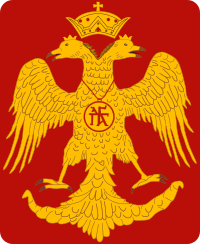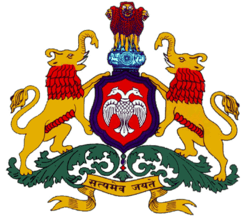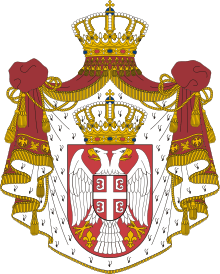Double-headed eagle

The double-headed eagle is a common symbol in heraldry and vexillology. It is most commonly associated with the Byzantine Empire, the Holy Roman Empire, the Serbian Empire, the Russian Empire and their successor states. In Byzantine heraldry, the heads represent the Emperor having authority over both secular and religious matters, Byzantine emperors were regarded as Christ's viceregent on Earth. It also signified the dominance of the Byzantine Emperors over both East and West. In the Holy Roman Empire's heraldry, it represented the church and the state. Several Eastern European nations adopted it from the Byzantines and continue to use it as their national symbol to this day.
Origins

Double-headed eagles have been present in imagery for millennia. The two-headed eagle can be found in the archaeological remains of the Hittite civilization, dating from a period that ranges from the 20th century BC to the 7th century BC. The Gandaberunda is another example of a mythological two-headed bird, which is in common use in India (The Kingdom of Mysore) .
Cylindric seals discovered in Boğazkale, an old Hittite capital in modern-day Turkey, represent clearly a two-headed eagle with spread wings. The aesthetics of this symmetrical position explains in part the birth of this religious figure: It originally dates from c. 3800 BC, and was the Sumerian symbol for the god of Lagash, Ninurta son of Enlil. It can also be seen in the same region in three monumental settings: Circa 1900 BC, during the Hittite surge from north-central Anatolia down into Babylonia; in Alacahöyük around 1400 BC; and in Yazilikaya before 1250 BC. Here the context looks slightly different and totally religious: The eagle returns to its ancient origins as a symbol of divine power. The two-headed eagle is seen less and less during the last Hittite period (from the 9th to the 7th century BC) and totally disappears after the end of the empire.
Kingdom of Mysore
The Kingdom of Mysore was a kingdom of southern India, traditionally believed to have been founded in 1399 in the vicinity of the modern city of Mysore. The kingdom, which was ruled by the Wodeyar family, initially served as a vassal state of the Vijayanagara Empire. With the decline of the Vijayanagara Empire (c.1565), the kingdom became independent. The 17th century saw a steady expansion of its territory and, under Narasaraja Wodeyar I and Chikka Devaraja Wodeyar, the kingdom annexed large expanses of what is now southern Karnataka and parts of Tamil Nadu to become a powerful state in the southern Deccan.
A roof sculpture depicting a Gandaberunda is found on the roof of the Rameshwara temple in the temple town of Keladi in Shimoga District(now Shivamogga). The Gandaberunda was used by the Wodeyar dynasty of Mysore as the Royal emblem. The Karnataka Government adopted this symbol as the state symbol and can be found on bus terminals and tickets issued by Karnataka State Road Transport Corporation. Coins (Gold pagoda or gadyana) from the rule of Achyuta Deva Raya are thought to be the first to use the Gandaberunda on currency
Byzantine Empire

Constantinople was the successor of Rome, and the Byzantine Greeks continued the use of the old imperial "single-headed" eagle motif. Although the roots of the transformation to double-headed are almost certainly connected with old depictions in Asia Minor, the details of its adoption are uncertain. It appears in Byzantine artwork as early as the 10th century, but it's confirmed in use by the Empire as such only much later, in the Palaiologos dynasty period, when it was used as a symbol of the Emperor and high-ranking members of the Imperial family.
The Ancients used no flags in the modern sense. The Romans used various signa, such as the bronze aquilas (adopted as the legions' symbol by Marius) and vexilloids, and, if the emperor was present, pikes or banners with the emperor's portrait. With the adoption of Christianity as state religion during the later Empire, the Chi-Rho and the cross became more and more used in military standards, such as the labarum. The Roman single-headed eagle however continued to be used as a symbol of imperial authority.
According to a popular story (which however lacks any direct support), the single-headed eagle was modified to double-headed by Emperor Isaac I Komnenos (1057–1059) being influenced from local traditions about such a (mythical) beast (the haga) in his native Paphlagonia in Asia Minor. Local legends talked about this giant eagle with two heads that could easily hold a bull in its claws; the haga was seen as a representation of power, and people would often "call" it for protection. Isaac Komnenos, deeply influenced by these beliefs, had already used it as a family emblem.[1]
Use by the Seljuk Turks (c. 1058 – 1246)

The double-headed eagle became the standard of the Seljuk Turks with the crowning of Tuğrul (meaning "Goshawk") Beg at Mosul in 1058 as "King of the East and the West" and was much used afterwards. The Sultans of Rum, Ala ad-Din Kayqubad I (1220–1237) and his son Kaykhusraw II (1237–1246) used the dicephalous eagle in their standards, and the motif was also found on tissues, cut stones, mural squares, and Koran holders.[2]
Turcomans who ruled in Anatolia during the 13th century, inherited it from the Seljuk Turks. Islamic coins from the reign of Khalif Nasreddin Mahmoud bin Mohammad, following Turkish influence, sporting a double-headed eagle on one side and the Star of David on the other as early as year 1200.
Holy Roman Empire (c. 1250 – 1806)

The first mention of a double-headed eagle in the West dates from 1250, in a roll of arms of Matthew of Paris for Emperor Frederick II of the Holy Roman Empire. Usually depicted black on a gold background, it replaced the earlier single-headed eagle, and was subsequently adopted in the coats of arms of many German cities and aristocratic families. After the dissolution of the Holy Roman Empire in 1806, the double-headed eagle was retained by the Austrian Empire, and served also as the coat of arms of the German Confederation.
Use by other countries

.svg.png)
From Byzantium, two-headed eagles spread to Russia after Ivan III's second marriage to Zoe Palaiologina (a niece of the last Byzantine emperor Constantine XI),[3] and to Montferrat, where a cadet branch of the Palaeologi ruled. It remains also an important motif in the heraldry of the imperial families of Russia (the House of Romanov), Austria-Hungary (the House of Habsburg), Serbia (the Houses of Karađorđević and Obrenović) as well as the royal family of Montenegro (the House of Petrovic).

The Double-headed eagle was a main element of the coat of arms of the Russian Empire, modified in various ways since the reign of Ivan III (1462–1505), and the shape of the eagle getting its definite Russian form at the reign of Peter the Great (1682–1725). The Double-headed eagle continued in Russian use until abolished - being identified with the Czar's rule - at the Russian Revolution in 1917; it was restored in 1993 after that year's constitutional crisis and remains in use up to the present, although the eagle charge on the present coat of arms is golden rather than the traditional, imperial black.
In England, the Mercian Kings used the double-headed eagle as a symbol prior to the Norman conquest. It was used by Leofric, Earl of Mercia to represent the ancient Shropshire family.[4]

In Scotland, the coat of arms of the city and burgh of Perth was supported by a double-headed eagle. The eagle later became the supporter of the arms of the district of Perth and Kinross (1975).[5]
The Serbian Nemanjić dynasty adopted a white version as their own to signify their own independence of, and indeed, claim to the imperial throne of Constantinople. The white eagle was retained by most Serbian medieval dynasties, as well as the Karađorđević, Obrenović and Petrović-Njegoš houses and remains to this day in use in the coat-of-arms of the countries of Serbia and Montenegro. It was the charge in the Coat of Arms of the Bulgarian Tsar Ivan Alexander (reigned 1331–1371). George Kastrioti (Skanderbeg) adopted a similar flag in his struggle against the Ottomans, consisting of a black eagle on red background, which has been resurrected in the current Flag of Albania. During the next centuries, the eagle was made to hold a sword and/or a scepter and an orb with a cross, symbols of the aforementioned double sovereignty.
Its usage also survived as an element in the Greek Orthodox Church, which was the inheritor of the Byzantine legacy during the Ottoman Empire, while it remained a popular symbol among Greeks and is still in use in Church flags. In modern Greece it is used officially by the Hellenic Army (Coat of Arms of Hellenic Army General Staff). It was also used as a charge on the Greek coat of arms for a brief period in 1925–1926.[6]
The two-headed eagle appears, often as a supporter, on the current and historical arms and flags of many countries and territories, including Albania, Armenia, Austria (1934–1938), Austria-Hungary, Byzantine Empire, German Confederation, Holy Roman Empire, Kingdom of Mercia (527–918), Montenegro, Kingdom of Mysore, Russian Empire, Russian Federation, Seljuk Empire, Serbia, Serbian Empire, Kingdom of Serbia, Spanish Empire (during the Habsburg dynasty), and Kingdom of Yugoslavia. It also appears on other coats of arms and flags, including the flag of the Greek Orthodox Church, the arms and flag of the Hellenic Army General Staff and the Hellenic Army XVI Infantry Division,[7] a number of cities in Germany, Netherlands and Serbia, the arms and flag of the city and Province of Toledo, Spain, and the arms of the town of Velletri, Italy.
Modern usage

Today, in Turkey, municipality of Diyarbakır and two football clubs of Turkey, Erzurumspor and Konyaspor, have a double-headed eagle in their coat of arms.
Albania, Serbia, Montenegro and Russia have a double headed eagle in their coat of arms.
Use in Masonry
The Double-Headed Eagle of Lagash is used as an emblem by the Scottish Rite of Freemasonry.[8] There are many meanings attached to this symbol. It has been introduced in France in the early 1760s as the emblem of the Kadosh degree.[9]
Use in sports
The double-headed eagle is the emblem of the Greek sport clubs AEK and (since their merger with AEK in 1929) P.A.O.K.. It is a symbol of the clubs' origins, since both were founded by Greek refugees who fled to Greece from Constantinople in the 1920s.[10] It is also the emblem of the Turkish Konyaspor[11] and Erzurumspor, the Dutch clubs NEC and Vitesse, the English League Two football club AFC Wimbledon and Scottish Premier League side Saint Johnstone FC.
Examples
-

First double-headed eagle as Reichsadler, from Chronica Majora, c. 1250
-

Hungarian noble arms of Balogh (c. 1300)
-

Double-headed eagle of Byzantine Emperor John VIII Palaiologos (R. 1425–1448)
-
.svg.png)
First Russian eagle (1472), adopted by Ivan III after marriage with Byzantine princess Sophia Palaiologina
-
.svg.png)
Coat of arms of the Austrian Empire (1815—1867)
-

Royal arms of Serbia (1882–1918 and 2004-)
-

Coat of arms of the Russian Empire (1883–1917)
-

Badge of the Mercian Brigade (1948–64), attributed to Leofric, Earl of Mercia (11th century)[1]
-

Coat of arms of the Russian Federation
-

Coat of arms of Albania (1992)
-

Coat of arms of Montenegro (2004)
- ^ "Mercian History". Mercian Volunteers Regimental Association. Archived from the original on 2007-09-29. Retrieved 2013-05-13.
See also
- Oksoko
- Double Eagle
- Eagle (heraldry)
- Gandaberunda
- Polycephaly
- Reichsadler
- Coat of arms of Austria-Hungary
- Divide and rule
Notes
- ↑ Zapheiriou, N. (1947). The Greek Flag from Antiquity to present. Athens, Greece. pp. 21–22.
- ↑ A picture can be found in Titus Burckhardt, Art of Islam, under the chapter on the Rum seljuks.
- ↑ Alfred Znamierowski (2003). Illustrated book of Flags. London: Southwater - Annes Publishing Ltd. p. 55. ISBN 1-84215-881-3.
- ↑ Notes and Queries - William White - Google Books
- ↑ "Perth and Kinross - Coat of arms". ngw.nl - Heraldry of the World. Retrieved 11 October 2013.
- ↑ Eleni Kokkonis-Lambropoulos & Katerina Korres-Zografos (1997). Greek flags, arms and insignia (Ελληνικές Σημαίες, Σήματα-Εμβλήματα) (in Greek). E. Kokkonis-G. Tsiveriotis. pp. 47, 51. ISBN 960-7795-01-6.
- ↑ Army.gr
- ↑ Scottishritemasons-can.org
- ↑ Pierre Mollier (2004), "The Double-Headed Eagle: iconographic sources of the masonic symbol", The Chain of Union (Special issue No.3): 5–15, retrieved 2011-10-30
- ↑ "History". PAOK F.C. Retrieved 11 October 2013.
- ↑ http://www.konyaspor.org.tr/
References
- Soloviev, A.V. (1935). "Les emblèmes héraldiques de Byzance et les Slaves". Seminarium Kondakovianum (in French) 7: 119–164.
External links
| Wikimedia Commons has media related to Double-headed eagles. |
- National Emblem of Russian Federation, 1993, The development of the use of the double-headed eagle in Russia (mirror of article Archived September 14, 2010 at the Wayback Machine from RF.Boom.ru)
- Heraldica.org, Page on the use of heraldry in the Byzantine Empire
- Metmuseum.org, Embroidered double-headed eagle on the podea of Paul, Patriarch of Constantinople (late 14th century) from the New York Metropolitan Museum of Art
| ||||||||||
| ||||||||||||||||||||||||||||||||||||||||||||||||||
